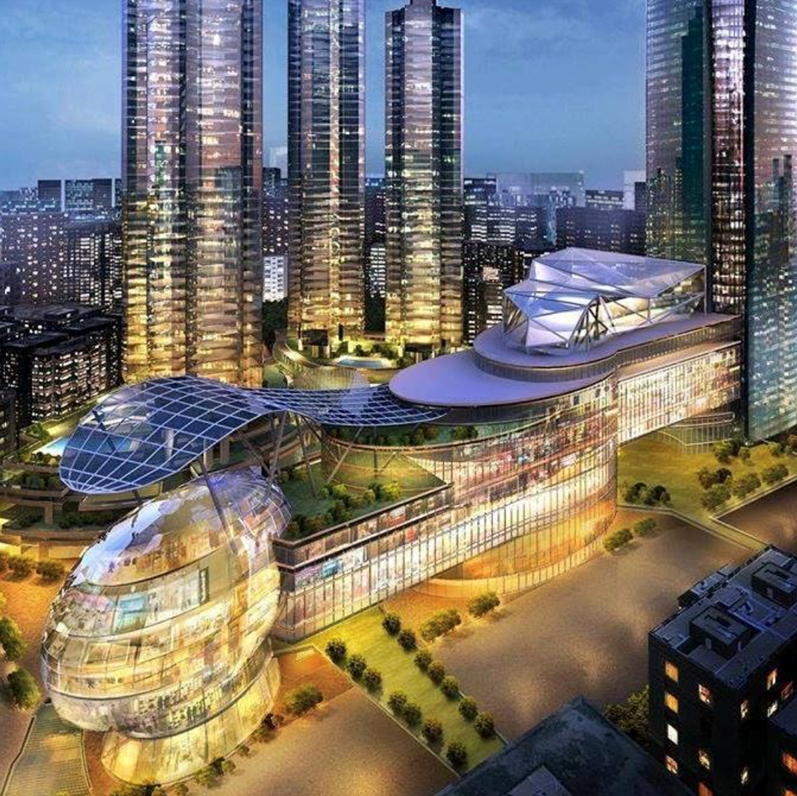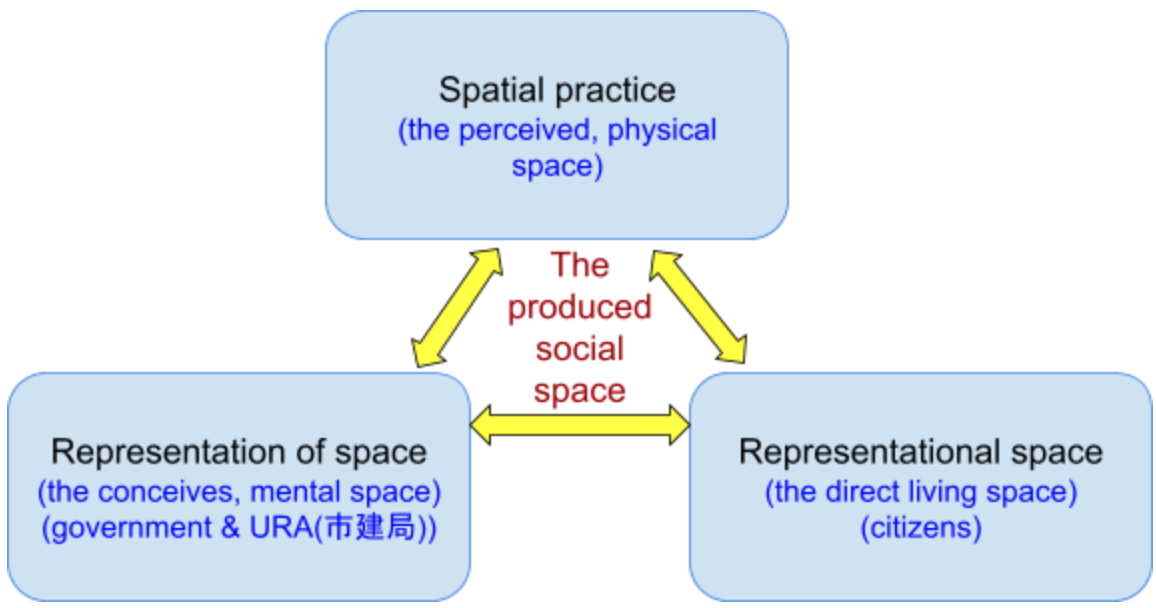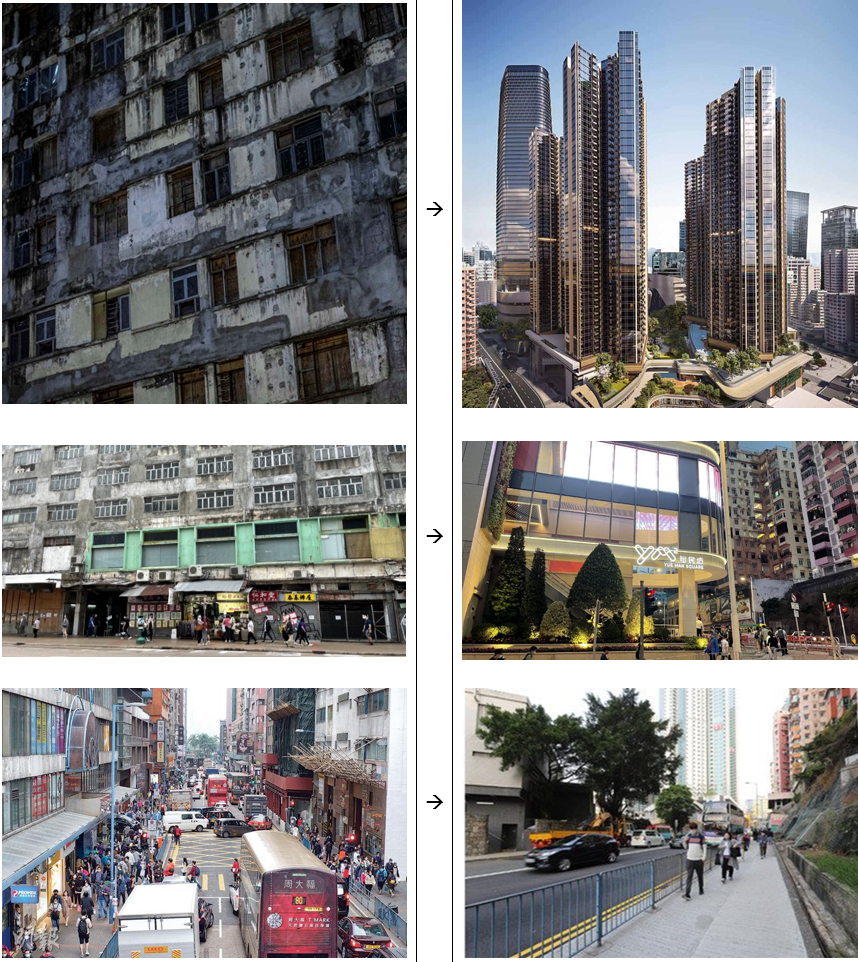
Figure 1. The ‘ideal’ planning of Kwun Tong Town Centre Redevelopment Project (Photo by URA)
1. Introduction
Advantages and disadvantages of Kwun Tong Town Centre Redevelopment are examined in this project. It is the largest-scaled redevelopment plan in Hong Kong which has covered over 570000 square feet of territory in Kung Tong (Fandom, 2004). Therefore, it deserves public attention. The Kwun Tong Town Centre could be seen as a cultural trace because it records Kwun Tong’s original residents’ usual lives. Due to lack of maintenance, outdated city plan and poor environmental hygiene, the government proposed to redevelop this city and thus give rise to this redevelopment plan (URA, 2011). In the followings, spatial triad, which includes spatial practice, representation of space and representational space, and stakeholders’ perspectives will be used to analyze the advantages and disadvantages of Kwun Tong Town Centre Redevelopment.
2. Cultural Geographical Perspective in Use
Henri Lefebvre (1991)’s spatial triad is being used to investigate how the Kwun Tong Town Centre Redevelopment Project has aroused several conflicts among different stakeholders.
According to Lefebvre (1991), spatial triads provide a framework for us to understand the three elements that essential in producing space (Figure 2). It contains:
· Spatial practice: the daily routines and usage of social space
· Representation of space: correlated to the relations of production and ‘order’; involves those in power on space design and urban planning, e.g. urbanist, social engineers, and government
· Representational spaces: people who directly live in the space, regarded as ‘users’ or ‘inhabitants’, embodies complex symbolisms regarding personal feelings and daily habitus

Figure 2: The illustration of Lefebvre (1991)’s spatial triad
To explain more, the above figure shows that spatial practice, the representation of space and representational space interact with each other and constitute the produced social space. The Kwun Tong Town Centre Redevelopment was initially promoted by the government aimed at improving the living space in Kwun Tong in various perspectives, including housing, traffic, and public utilities, etc.. However, during the years-long redevelopment progress, the representation of space (government and URA) is in conflict with the representational space (local Kwun Tong citizens), the difference in values among these two stakeholders will be examined further in the empirical analysis part.
3. Empirical Analysis
In the former spatial practice, there exist natural, social and spiritual needs of local residents, workers and travelers. To resolve pre-existing or newly emerging needs, the government launched the Kwun Tong Redevelopment project, which provides Kwun Tong with new representations of space. Eventually, residents and facility users in Kwun Tong experience a tremendous change in the way they live, showing the formation of a new representational space with profound advantages.
First and foremost, the poor living standard in Kwun Tong is an urgent and severe issue that needs huge improvement. Kwun Tong’s long development history results in aged and worn-out buildings with water leakages, windows loosening and even concrete cracking(市區重建局 影片集, 2011). Pornography industries are found due to inadequate monitoring and management. The old Tong Lau is also unsanitary with excrement of humans and animals, and lacks fire‑fighting equipment and elevators (市區重建局, 2011). Hence, the unsatisfying hygiene situation and living environment threaten the safety of residents and pedestrians. The social need for a better living environment in the past spatial practice resulted in the clearance of aged Tong Lau and construction of new private residential buildings, namely Park Metropolitan and Grand Central, which provides comfortable and safe housing estates. As a consequence, the living quality and safety of citizens can be enhanced.
Next, the necessity of industrial transformation in Kwun Tong calls for the implementation of the redevelopment plan. Owing to the decline of local industries and increase of residents, Kwun Tong is no longer a prosperous industrial district, but mainly a residential area. The social needs for economic development foster the redevelopment of the industrial areas for building shopping and commercial areas. The Tertiary Industry and service Industry such as Yue Man Square eventually developed and substituted the past manufacturing Industry, thus enhancing the local economy and achieving industrial upgrading (港mall專題, 2021). In the meantime, it is worth noticing that the economic growth compromise with residents’ request for retaining original l stores and local hawkers by renting out shops and stalls in shopping malls to local tenants at a reasonable price, reflecting the balance achieved between social-economic benefits and citizens’ psychosocial needs for collective memory and neighbour relations(WangBertha, 2018).
Moreover, the town planning of Kwun Tong is outdated. Kwun Tong aimed to serve fifty thousand people in the 1950s, yet the usage has increased to a million now. This makes the carrying capacity overloaded and causes social problems such as traffic congestion, overcrowding and improper walking environment(市區重建局,2021). Companies complained that incompetent transportation in the district reduced logistic efficiency, while citizens suggested that insufficient barrier-free access and facilities together with narrow sidewalks pose inconvenience and danger to pedestrians. Therefore, by modification works on transport systems and traffic and construction of a novel Yue Man Square Public Transport Interchange in the representations of space, social needs in the previous spatial practice are expected to be solved (香港道路大典, 2004). In the end, a new representational space forms with improved transport efficiency and safety.
In addition, Kwun Tong has insufficient public facilities such as public toilets and accessible facilities(市區重建局, 2011). Owing to the massive population in Kwun Tong, various social facilities are added after the redevelopment. For instance, enhancing communication between citizens and Mother Nature, greening and leisure areas satisfy citizens’ needs in natural space(文化研究@嶺南,2007). The community health centre also provides space for recreational activities and socialization, which fulfil residents’ social needs. Indeed, numerous residents rest and interact there in the new representational space, successfully revitalizing the district.
Redevelopment is an effective way to alleviate issues in Kwun Tong. Besides solving the root problems, it also improves the ventilation, increases cultural recreations and promotes greening of the city(市區重建局,2021). The quality of life and financial condition of citizens is enhanced.
However, conflicts between stakeholders exist that some original residents and merchants are reluctant to accept the redevelopment scheme(香港電台, n.d.).
From the view of the original merchants, they have owned their shop for years, and have built up a strong relationship with their business and local residents(香港01, 2021). This is hard for them to move out from their habitat. Although they are compensated by the government, the compensation standard is ambiguous(香港電台, n.d.). Even if they get the preference to allocate in the new shopping malls, they must pay for expensive rent and maintenance fees. Besides, shopping malls consist of complicated regulations such as opening time, and merchants have less freedom than before. The change of shopping mode also leads to succession of customers, which makes their business uncertain(hket, 2021). Some of the unlicensed merchants have nowhere to continue their business. Multifactor makes them unable to continue their work.
From the perspective of the original residents, the construction of shopping malls reduces their purchasing power. The succession from multiple merchants into high-class chain stores in shopping malls makes the local business homogenous(文化研究@嶺南, 2007). The price of goods no longer matches the income of the residents. Although building new shopping malls speeds up economic development, the living of the underprivileged goes worse.
Redevelopment undoubtedly solved physical problems, but it also broke down the social linkage in Kwun Tong between not only merchants and residents but also the sense of belonging and people’s impression. Redevelopment acts as hegemony and changes the original traces such as from cheap products to materialism and historical buildings to new shopping malls. Its appearance is not as before, and it is less distinguishable from others.
In conclusion, space is ever-evolving in a dynamic and coherent way. Different spatial needs result in reconstruction and representations of space, which in turn leads to a novel representational space, eventually producing new spatial needs. This indefinite circulation of spatial creation and reconstruction give rise to different cultures, traces and geographical landscapes with their beauty and art to behold (Figure 3).

Figure 3: Transformation of the Kwun Tong Town Centre
4. Conclusion
In a nutshell, this group project has utilized the spatial practices of natural, social, and spiritual needs among Kwun Tong residents, workers and travelers to examine the advantages of redeveloping Kwun Tong Town Centre. Together with the theory of spatial triad, it is recognized that all the three elements including spatial practice, representation of space, and representational space, are indispensable in constructing the produced social space. For the advantages of redevelopment, in government and URA’s perspectives, the redevelopment projects can all increase the natural, social, and spiritual needs of the citizens by improving living standards, the urge of industrial transformation, better city planning, and enhancing public facilities. However, an antagonistic relationship can also be found between the government and local citizens and merchants. The collision in values among the stakeholders have also affected the three elements of spatial triad impact and influence each other.
References:
裕民坊. 香港道路大典. (2004). Retrieved December 7, 2021, from https://hkroad.fandom.com/wiki/%E8%A3%95%E6%B0%91%E5%9D%8A#.E6.AD.B.
市區重建局 影片集.(2011年11月18日).〈觀塘市中心計劃背景介紹短片「重建觀塘、刻不容緩」〉. Retrieved December 7, 2021, from https://www.ura.org.hk/tc/video/2011
港mall專題(2021年4月10日)。<凱滙商場真係高格調?市建局 觀塘裕民坊YM2 的定位、發展方向與隱憂>。 取自
香港電台(n.d.)。<《原來係咁》觀塘重建>。 取自
https://www.rthk.hk/tv/dtt31/programme/830_magazine/episode/728186/miniepisode/165
端傳媒(2019年3月2日)。<影像:觀塘裕民坊 重建前的最後時光>。 取自
https://theinitium.com/article/20190302-photo-farewell-yue-man-square/
香港01(2021年5月17日)。<觀塘重建|僅存果汁舖今拉閘遷出 裕民坊正式步入歷史>。 取自
香港01(2021年6月9日)。<觀塘重建|男子疑不滿賠償問題 裕民坊天台危站 談判專家到場>。 取自
市區重建局(2021年3月14日)。<觀塘市中心重建計劃 倍增社區設施 改善人車環境>。 取自
https://www.ura.org.hk/tc/media/blog/blog_20210314
hket(2021年10月3日)。<【觀塘重建】裕民市集開幕近半年引逾百小販進駐 營運初期丁財不旺>。 取自
文化研究@嶺南(2007年3月)。<重建的市區──被規劃的城市生活記憶>。 取自
https://www.ln.edu.hk/mcsln/archive/4th_issue/pdf/feature003.pdf
市區重建局(2021年4月15日)。<觀塘重建項目進度報告>。 取自
立場新聞(2017年9月27日)。<觀塘重建被批走數 市建局:將維持原設計「神髓」 包括蛋形建築>。 取自
WangBertha(2018)。〈裕民坊的最後探戈〉。《好習慣》。取自https://www.betterme-magazine.com/%E5%9C%96%EF%BC%8E%E5%9F%8E%EF%BC%8E%E8%A8%98/%E8%A3%95%E6%B0%91%E5%9D%8A%E7%9A%84%E6%9C%80%E5%BE%8C%E6%8E%A2%E6%88%88/
LeungStanley.(2019年3月2日). 〈影像:觀塘裕民坊 重建前的最後時光〉. 端傳媒. 擷取自: https://theinitium.com/article/20190302-photo-farewell-yue-man-square/
覓至房. (2021年7月12日). 〈凱滙第一期〉. 擷取自: https://www.richitt.com/grandcentralphase1/
曾曉玲. (2020年12月20日). 〈未來城市:觀塘塞車荒謬——點先有路走?〉. 《明報OL網》. 擷取自: https://ol.mingpao.com/ldy/cultureleisure/culture/20201220/1608402229462/%E6%9C%AA%E4%BE%86%E5%9F%8E%E5%B8%82-%E8%A7%80%E5%A1%98%E5%A1%9E%E8%BB%8A%E8%8D%92%E8%AC%AC-%E9%BB%9E%E5%85%88%E6%9C%89%E8%B7%AF%E8%B5%B0
Lefebvre, H. (1991). The production of space. Oxford: Blackwell.


